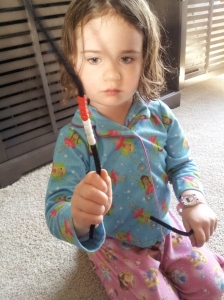How are you feeling about your child’s knowledge of addition and subtraction facts? Are you worried that he hasn’t memorized them yet. Worried that his teacher isn’t focusing on facts enough? Well, if you’re older than 18, you probably learned math very differently than your child is learning math today. Here are a couple of tidbits that differ greatly from math instruction in “our day” and math instruction today:
1. The Common Core State Standards for Mathematics specify that children should learn their addition and subtraction facts through strategy work, not from drill and practice.
2. The standards outline that, by the end of kindergarten, kids should “add and subtract fluently within 5” which means that they should be able to add or subtract any numbers up to 5 and get the correct answer with relative speed. By the end of first grade kids should be able to do this within 10 and that not until the end of second grade should they “know all sums within 20 from memory.”
So how can you help your child with math homework if you don’t know how they’re supposed to learn their facts? I’m just going to lay it out on the table – talk to your child’s teacher first if you’re not sure what to do or how to help. Also, remember that your job is to help your child “figure it out” not to do the thinking for him. Beyond all that, here’s an amazing tool you can create and use to help your child at home.
Ready for it? It’s called a . . . Rekenrek. If it’s easier, call it a number rack. Literally translated it means arithmetic rack and it was created in the Netherlands. It was invented a good time ago to help children understand the number system, develop number sense and improve computational fluency (learn addition and subtraction facts).
Rekenreks are easy to build. All you need is 2 black pipe cleaners, 10 red pony beads, 10 white pony beads and a piece of foam board (a piece about 4 inches by 8 inches is plenty big). Cut 2 slits on the short sides of the board, evenly spaced between each other and the edges of the board. String 5 red and 5 white beads on each pipe cleaner and pull through the slits on the foam board. It is important to make sure that the bead color lines up on both pipe cleaners. When completed, all beads should be pushed to the right and the beads on the left should be red and the beads on the right should be white. See the images below.
These are easy to build and there is value in having your child build it (with guidance). On a Rekenrek, each bead represents 1 so by building it himself, your child will see the embedded structure of 5 red and 5 white to make 10 and the overall structure of 10 and 10 to make a total of 20.
So here’s how the Rekenrek can help your child. When working on facts, typically your child only sees the numeral (the symbol for the number). Using the Rekenrek allows your child to see the quantity attached to each number. Through practice your child will eventually come to just know these facts. What’s more, your child is likely learning strategies for adding and subtracting. For example, many children learn doubles (4+4, 5+5) automatically. Children can use this knowledge to solve near doubles. Children recognize that in the problem 6+7, 7 can be split into a 6 and 1 to make the problem 6+6+1. The problem with this strategy is that because children easily memorize doubles they don’t “think” about what the fact means. So asking them to use the double to solve a close fact isn’t always intuitive. Demonstrating this on the Rekenrek lets your child literally see the double plus 1.
Work with Rekenreks support much more basic understanding of number as well. Rekenreks help children subitize (recognize small quantities without counting) and work with composing and decomposing numbers.
Below are links to 2 activity guides (meant for the classroom) you could use with your child to support understanding of numbers and operations. They are free!
Using the Rekenrek as a Visual Model for Strategic Reasoning in Mathematics
From the Math Learning Center – an in-depth series of lessons that builds from most basic number sense skills to addition and subtraction activities.
Mathrack Activities and Directions
From Mathematically Minded – a brief description of activities as well as assembly instructions.




